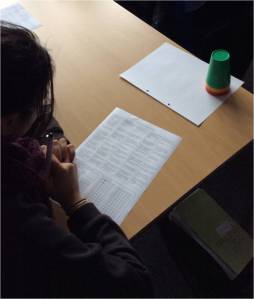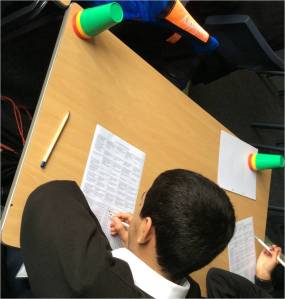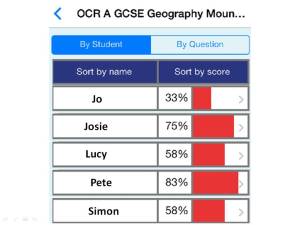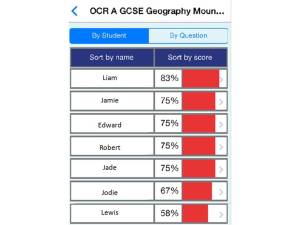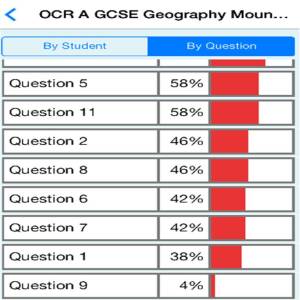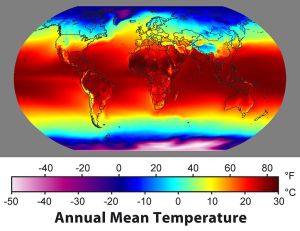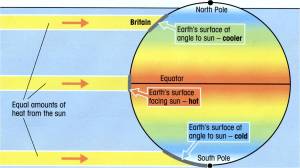Student voice questions
As this was their first experience of a test containing a significant number of hinge questions, I was interested in gathering a snapshot of what the students in the class thought about the experience. To assist, I asked students to complete an exit ticket containing four basic questions,
(1) Did you find the questions on the quiz “hard”?
(2) If so, what made the quiz challenging?
(3) To what extent would you say this type of quiz is good at helping you discover what you don’t know and what areas of the mountains topic you might need to focus on?
(4) Do you have any other comments?
Student voice results
Interestingly, every one of the students responded that they thought the questions were hard! Broadly speaking, many students responded that this was due to the fact that the distracters were very similar and this forced them to think deeply about their responses.
“You had to know what all of them meant to be able to answer the question”.
“The answers were similar to each other with only small differences which made one of them correct”.
“The questions are challenging and make you think about the answer, they make you double check”.
“They were hard because they were all logically similar, none stood out as “right”.
“They were tricky because there were certain details where in some places wording or information overlapped and left me puzzled between some answers”.
These results suggest that applying some of the principles behind hinge question design are reasonably effective in generating a deeper level of thinking in students.
In terms of how useful students found this kind of question design, student responses focused around the following…
“They are useful because they quickly tell me what I need to revise”.
“They help me pick on areas where my knowledge is weaker than others”.
“They are good at helping us find out what we don’t know and the areas which we need to improve and possibly focus on.”
Again, these responses suggest that a hinge question quiz can act as a useful tool for helping students to diagnose content areas that need some further reinforcement or development.
Student criticism of hinge questions
In resonse to the “any comments?” section, some students responded with some interesting criticisms of the method.
“These questions don’t help me improve my written responses”.
“I would rather do test papers as they help me prepare for the real exam”.
“It doesn’t help us to write written answers as we may not know how to phrase them”.
While I can understand the student point of view here, exam technique and students written communication is a skill set that this particular hinge question quiz did not seek to assess. The aim was to assess the extent of knowledge acquisition and level of understanding relating to mountain environments. Transferring that knowledge and understanding into a clear written exam response requires, amongst other things, an understanding of command words and effective written communication. I would argue that securing the knowledge and understanding around key learning points is the priority, exam technique and literacy development are embedded into lesson activities as we progress through the specified content. I will be interested to explore if the students performance in the mountains exam paper is any better than I might have anticipated after completion of the hinge quiz. This would make a very interesting area for further research. That said, what the quiz is, and isn’t assessing (and why) is something that I think is worth clearly communicating to students before they attempt future hinge question assessments.
A second criticism of the approach related to the nature of multiple choice assessments.
“You know it is going to be one of the options so you can just guess if you don’t know”.
“If the question was hard and I didn’t get it I just guessed. If I didn’t have a particular letter in a while I would put it down as that!”
If students guess the answer and get it correct, this is going to generate inaccurate data regarding student learning. To address this issue, when deploying future hinge question quizzes I’ll communicate to students that if they are unsure of an answer, leaving it blank is preferable to guessing the response!
Reflecting on the issue around guessing the response highlights the permeating culture in schools where students (and teachers) attach a high stakes approach to assessment opportunities. Despite my best efforts, the culture of getting it right first time and doing well on the test still dominates in the minds of most students I teach. The alternative view of seeing the quiz as an opportunity to identify areas to develop is one which needs to be continually articulated if I am to create a more productive learning culture in my geography classroom.

